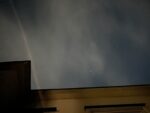2024-10-07 19:36:00
Prototype Automatic Ground Station 2
Vienna, Austria
Austria
NOAA-19

On my way to work, I see a posy of flowers and candles arranged around a group of 'stumbling stones' (Stolpersteine) for Jewish Holocaust victims. The care and thought contained in the small act of memorialising such unfathomable violence moves me. Yet, I also feel disquiet at the possible mnemonic "fusing" of the October 7 attacks with the Holocaust. In a Guardian article, 'How Israel has made trauma a weapon of war', Naomi Klein asks what are the dangers (and motivations) of making such parallels? Klein's arguments have resonances beyond Gaza to other contexts where work is being done to remember the violence and victims of war. Sasha, I am thinking of your 'pilot' research into your family's Balkan ancestry, knowledge of wind and other more-than-meteorological weathers. I am thinking too about how half a decade ago I tried and mostly failed to write about the flawed efforts of Western NGOs to record and so mark the deaths and injuries of civilians in the wake of US-led aerial bombing campaign against the so-called 'Islamic State' in Iraq and Syria. The questions that recur, for me, are about how the memorialisation of "traumatic histories can be done in ways that encourage collective healing and a sense of solidarity across divides" (Klein 2024). And, how when this is not the case, throughout history the transmission of trauma has been used to stir revenge and justify punitive campaigns of violence. Conversely, too, how when public or collective acts of remembrance are forbidden, mourning becomes an act of resistance. Remembering or "zochrot" in Hebrew, writes Klein, "in its truest sense is about putting the shattered and severed pieces of the self together (re-member-ing) in the hopes of becoming whole" (Klein 2024).
2024-07-25 22:53:01
Soph Dyer
Lacknergasse, Wien
Wien
NOAA-18



Cool temperature. Still night. There is a thin film of cloud.
Earlier, inn the hospital, I read a draft of Wind’s Animacies by Sasha. The article sweeps me up, taking me far from the fluorescent lighting and airless weather of the waiting room. I turn over her question, "what does the wind remember?" I am moved by it, perhaps because I am grappling with how to reorganise or cohere a messy medical history of ill health with the new knowledge that comes with a diagnosis.
I find myself caught between wanting to forget the lost days in bed with a pillow tucked under my abdomen, or the sleepless nights and listless days that followed. Could an earlier diagnosis have changed the course of my access to treatment? This is is both too painful and utterly pointless to think about.
I want to reorganise my memories into a tidy narrative of endometriosis, cysts and fibroids, rather than the current cluster of unexplained, possibly unrelated symptoms that moved around my body to the extent that I stopped trusting myself as reliable narrator.
I am thinking with Sasha's words: is pain is similar to wind? Neither are immaterial or material. Is pain not energetic, “slippery”, “leaky”?
Thinking about wind’s memory is an analytic move away from asking “where does the wind come from?” (n.d. Engelmmann) A question that forces an artificial cut into time to arrive at a single origin point. I exercise changing the familiar questions “Where does the pain originate?” or “When did the pain begin?" to “What does my body remember?” This new question requires me to relearn to trust it my body and its complaints. To piece it back together.
In a wholly different context, that of the 2016 US presidential election, American essayist and anarchist Rebecca Solnit writes “when the subject is grim, I think of the act of naming as diagnosis.” Diagnosis does not equal a cure, but it is an act of recognition that has the potential to reorganise and make sense of memories.